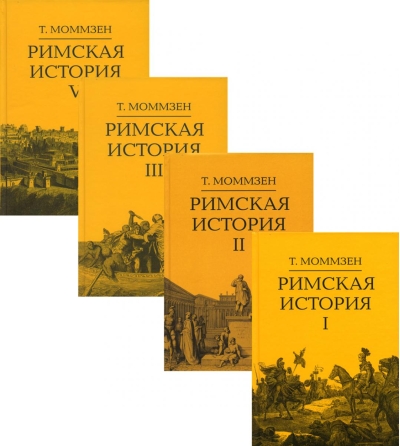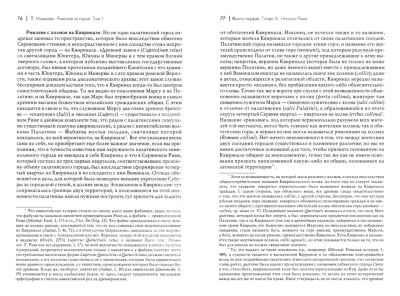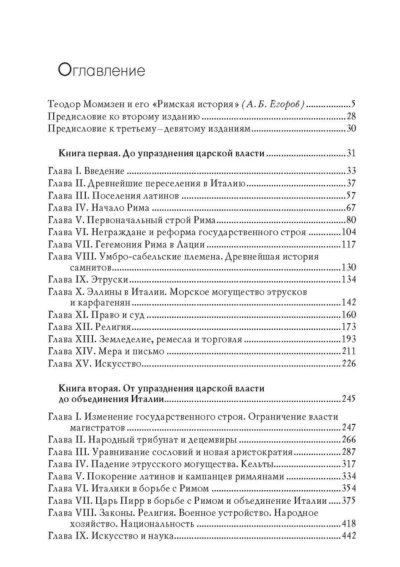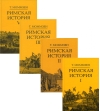Roman History. In 4 Volumes
149.99 €
The only thing available 2
The Roman History is a truly monumental work by Theodor Mommsen (1817–1903), who became the first German to receive the Nobel Prize in Literature (1902) and was described as "the greatest living master of historical literature" largely thanks to this work.
An outstanding classicist, philologist, and traveler, Mommsen relied on a vast amount of factual material collected and systematized after years of scientific expeditions in Italy. These expeditions culminated in the creation of the so-called "Corpus of Latin Inscriptions," comprising 180,000 different written sources, which formed the basis of the Roman History.
The events of its first volume span a vast period of antiquity: from the reign of the semi-legendary seven Roman kings and the unification of Italy under the Senate to the Third Battle of Pydna (168 BC), which ended the Macedonian Kingdom and led to the final establishment of democracy in the Hellenic lands.
The events of its second volume extend from the period of the conquest of the Hellenistic East and the beginning of the Age of Reform to the establishment of the dictatorship of Lucius Cornelius Sulla and the profound crisis of the republican form of government, which became the harbinger of the transition to the future Roman Empire.
The events of its third volume begin with the political instability that followed the death of the dictator Sulla (78 BC) and continue through the final civil war of the Republic (49-45 BC), bringing to the forefront the figure of Gaius Julius Caesar, whom the author considered a hero not only of Roman but of world history.
The concluding fifth volume provides a detailed description of the provinces of the empire, which forever remained one of the most grandiose state formations in the world. At its height, its authority extended over a total area of 6.51 million square kilometers. Roman law prevailed wherever the Roman legionary's caligae trampled the soil: from silver-rich Lusitania in the West to sparsely populated, deserted Syria in the East, from fertile Cyrenaica in the South to impoverished Britain in the North.
This book provides a detailed description of the political system, military affairs, diplomacy, economics, and culture of Rome, as well as its adversaries and allies. This publication serves as a resource for studying the history of the greatest ancient civilization, which forms the foundation of modern Western society. It is suitable for students and teachers of history, cultural studies, and political science, as well as anyone interested in world history.
An outstanding classicist, philologist, and traveler, Mommsen relied on a vast amount of factual material collected and systematized after years of scientific expeditions in Italy. These expeditions culminated in the creation of the so-called "Corpus of Latin Inscriptions," comprising 180,000 different written sources, which formed the basis of the Roman History.
The events of its first volume span a vast period of antiquity: from the reign of the semi-legendary seven Roman kings and the unification of Italy under the Senate to the Third Battle of Pydna (168 BC), which ended the Macedonian Kingdom and led to the final establishment of democracy in the Hellenic lands.
The events of its second volume extend from the period of the conquest of the Hellenistic East and the beginning of the Age of Reform to the establishment of the dictatorship of Lucius Cornelius Sulla and the profound crisis of the republican form of government, which became the harbinger of the transition to the future Roman Empire.
The events of its third volume begin with the political instability that followed the death of the dictator Sulla (78 BC) and continue through the final civil war of the Republic (49-45 BC), bringing to the forefront the figure of Gaius Julius Caesar, whom the author considered a hero not only of Roman but of world history.
The concluding fifth volume provides a detailed description of the provinces of the empire, which forever remained one of the most grandiose state formations in the world. At its height, its authority extended over a total area of 6.51 million square kilometers. Roman law prevailed wherever the Roman legionary's caligae trampled the soil: from silver-rich Lusitania in the West to sparsely populated, deserted Syria in the East, from fertile Cyrenaica in the South to impoverished Britain in the North.
This book provides a detailed description of the political system, military affairs, diplomacy, economics, and culture of Rome, as well as its adversaries and allies. This publication serves as a resource for studying the history of the greatest ancient civilization, which forms the foundation of modern Western society. It is suitable for students and teachers of history, cultural studies, and political science, as well as anyone interested in world history.
See also:
- All books by the publisher
- All books by the author
- All books in the series Historical technologies















